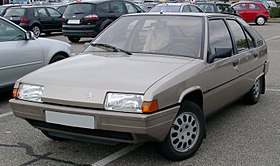Citroën BX
| Citroën BX | |
|---|---|
 |
|
| Overview | |
| Manufacturer | Citroën |
| Production | 1982—1994 |
| Assembly |
Rennes, France Vigo, Spain |
| Designer | Marcello Gandini |
| Body and chassis | |
| Class | Large family car (D) |
| Body style | 5-door hatchback 5-door estate |
| Layout | Front-engine, front-wheel drive / four-wheel drive |
| Related | Peugeot 405 |
| Powertrain | |
| Engine | |
| Dimensions | |
| Kerb weight | 870 kg (1,918 lb) - 1,220 kg (2,690 lb) |
| Chronology | |
| Predecessor | Citroën GS |
| Successor | Citroën Xantia |
The Citroën BX is a large family car that was produced by the French manufacturer Citroën from 1982 to 1994. In total, 2,315,739 BXs were built during its 12-year history. The hatchback was discontinued in 1993 with the arrival of the Xantia, but the estate continued for another year. The BX was designed to be lightweight, using particularly few body parts, including many made from plastics.
The Citroën BX was announced in June 1982, but its commercial life really only began in the Autumn of that year, with a Paris presentation on 2 October 1982 under the Eiffel Tower. The BX was designed to replace the successful small family car Citroën GS/GSA that was launched in 1970, with a larger vehicle (although the GSA continued until 1986). The French advertising campaign used the slogan "J'aime, j'aime, j'aime" showing the car accompanied by music written specially by Julien Clerc. The British advertising campaign used the slogan "Loves Driving, Hates Garages", reflecting the effort of Citroën to promote the reduced maintenance costs of the BX, over the higher than average maintenance costs of the technologically advanced GS/GSA; while still performing in the Citroën style on the road.
The angular hatchback was designed by Marcello Gandini of Bertone, based on his unused design for the British 1977 Reliant FW11 concept and his 1979 Volvo Tundra concept car. It was the second car to benefit from the merger of Peugeot and Citroën in 1976, the first being the Citroën Visa launched in 1978. The BX shared its platform with the more conventional 405 that appeared in 1987, except the rear suspension witch from Peugeot 305 Break. Among the features that set the car apart from the competition was the traditional Citroën hydropneumatic self-levelling suspension, extensive use of plastic body panels (bonnet, tailgate, bumpers), and front and rear disc brakes.
...
Wikipedia
